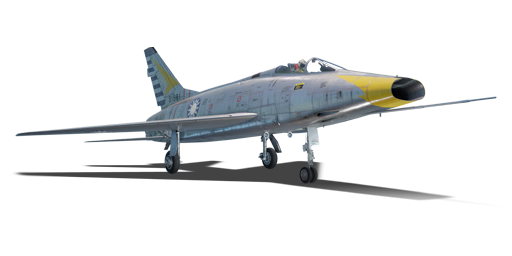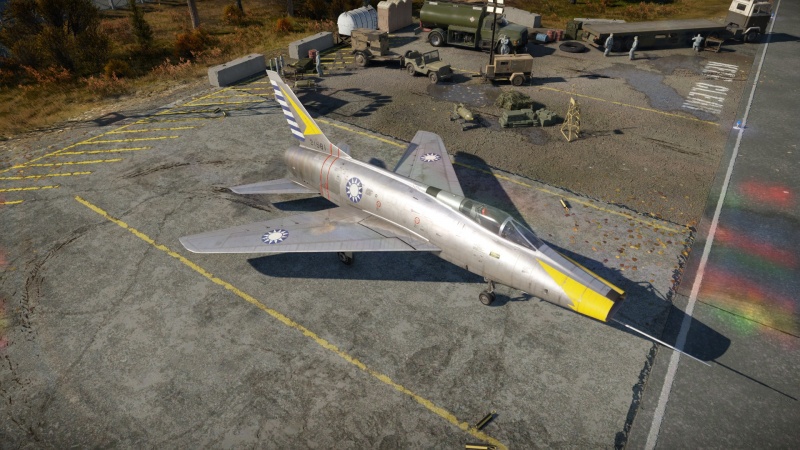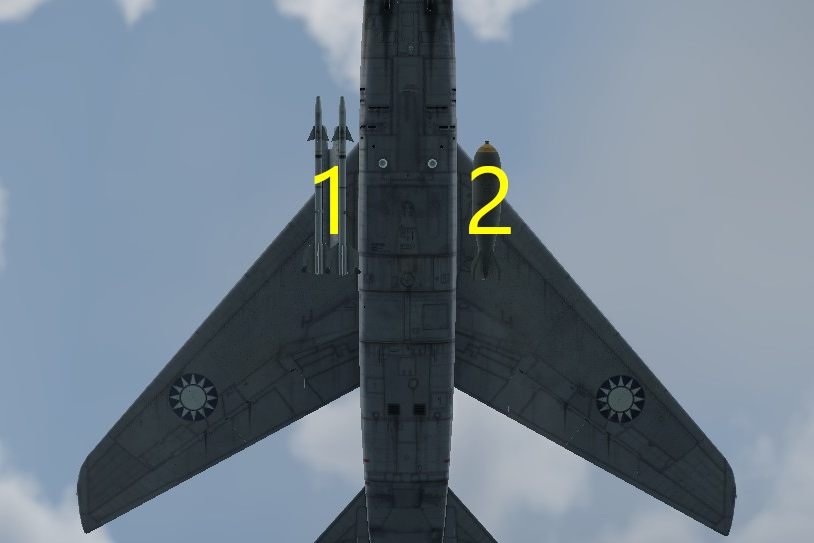F-100A (China)
| This page is about the jet fighter F-100A (China). For other versions, see F-100 (Family). |
Contents
Description
The ␗F-100A Super Sabre is a rank VI Chinese jet fighter with a battle rating of 9.7 (AB/SB) and 9.3 (RB). It was introduced in Update 1.97 "Viking Fury".
The first supersonic jet available in the ROCAF fighter line of the China tree, the F-100A is an early variant of the famous "Super Sabre", though in Taiwanese service it received a number of upgrades to bring it up to par with later models. Compared to the fighter-bomber F-100D, it has a smaller wing with a straight trailing edge, fewer hardpoints, and no flaps. It also has an early J57P7 engine that produces less thrust than the D model's J57P21. The speed and acceleration remain comparable since the F-100A weighs less.
The F-100A's handling generally feels lighter than the F-100D and it enjoys a better roll rate, though the lack of flaps impacts low speed manoeuvrability. The weapons selection is inferior: while it can still carry goodies like the AGM-12B Bullpup and the AIM-9B Sidewinder, its bomb selection is far more limited and it lacks access to unguided rockets and the more advanced AIM-9E Sidewinder. Still, it has a very solid gun armament of four M39A1 20 mm cannons. With careful speed management, the F-100A can swoop in and swiftly take down its enemies.
General info
Flight performance
As mentioned earlier, the F-100A handles like a lighter version of the F-100D. The acceleration is decent for an early supersonic jet but falls behind some contemporary 9.7 jets such as the J-6A and Q-5A, not to mention the J-7II (9.3 in RB). The top speed is about the same as the Q-5 early and lower than the F-100D. Turning performance is generally similar or improved compared to the F-100D. It can pull harder, which is helpful for snapshots, but there is also a risk of snapping the wings off in hard turns at high speed. The roll rate is improved. Controls stiffen at supersonic speeds. The low speed handling is poor and there are no flaps to help out. Turning energy retention is quite good at high subsonic speeds and not great elsewhere.
| Characteristics | Max Speed (km/h at 10,671 m) |
Max altitude (metres) |
Turn time (seconds) |
Rate of climb (metres/second) |
Take-off run (metres) | |||
|---|---|---|---|---|---|---|---|---|
| AB | RB | AB | RB | AB | RB | |||
| Stock | 1,357 | 1,349 | 15240 | 29.5 | 30.3 | 104.7 | 93.2 | 900 |
| Upgraded | 1,387 | 1,370 | 28.5 | 29.0 | 139.1 | 121.0 | ||
Details
| Features | |||||
|---|---|---|---|---|---|
| Combat flaps | Take-off flaps | Landing flaps | Air brakes | Arrestor gear | Drogue chute |
| X | X | X | ✓ | X | ✓ |
| Limits | ||||||
|---|---|---|---|---|---|---|
| Wings (km/h) | Gear (km/h) | Flaps (km/h) | Max Static G | |||
| Combat | Take-off | Landing | + | - | ||
| 1361 | 447 | N/A | N/A | N/A | ~11 | ~4 |
| Optimal velocities (km/h) | |||
|---|---|---|---|
| Ailerons | Rudder | Elevators | Radiator |
| < 640 | < 540 | < 610 | N/A |
Engine performance
| Engine | Aircraft mass | |||||
|---|---|---|---|---|---|---|
| Engine name | Number | Basic mass | Wing loading (full fuel) | |||
| Pratt & Whitney J57P7 | 1 | 9,079 kg | 315 kg/m2 | |||
| Engine characteristics | Mass with fuel (no weapons load) | Max Takeoff Weight | ||||
| Weight (each) | Type | 9m fuel | 20m fuel | 31m fuel | ||
| 900 kg | Afterburning axial-flow turbojet | 9,737 kg | 10,489 kg | 11,272 kg | 13,141 kg | |
| Maximum engine thrust @ 0 m (RB/SB) | Thrust to weight ratio @ 0 m (WEP) | |||||
| Condition | 100% | WEP | 9m fuel | 20m fuel | 31m fuel | MTOW |
| Stationary | 3,383 kgf | 5,616 kgf | 0.58 | 0.54 | 0.50 | 0.43 |
| Optimal | 4,004 kgf (1,200 km/h) |
8,056 kgf (1,200 km/h) |
0.83 | 0.77 | 0.71 | 0.61 |
Survivability and armour
- 64 mm bulletproof glass: windscreen
- 12.7 mm steel: behind pilot
For post-war fighter jets wanted to take advantage of the newer jet technology and maximize both speed and ordnance carried. To keep up speed and maximize ordnance, something had to give and that came with pilot survivability. The idea is to be faster than the enemy which would make it really difficult for them to get a targeting solution on you. Though the F-100A does have protection for the pilot, it isn't much and leaves the rest of the critical components virtually unprotected with armour. For the pilot, the back of the seat and headrest maintains a continuous piece of steel at 12.7 mm thick and the windscreen is rated at 64 mm bulletproof windscreen. Typically this type of protection is meant more for protection from defensive turret attacks from bombers rather than gun attacks from other aircraft.
The F-100A is a relatively sturdy aircraft and can take a beating before critical components begin to fail. While the engine and the pilot are important to protect as much as possible (without the engine you don't go and without the pilot…you don't go…) the wings are another critical component which you must protect as hits to the wings can make flying very difficult or send you to the respawn point. If being tailed by another aircraft try to speed away because if you try to pull up, turn to the side or pull-down, you risk exposing increased surface area of the skin, giving the enemy pilot more to shoot at and a greater opportunity of taking out a wing. If possible, increase speed and sway back and forth, even some very shallow elevator dips up and down maybe enough to throw off the sighting of the enemy pilot and spray his bullets all around you without exposing very much surface area of the jet, however, if there is a missile launch, take evasive action to avoid the missile and worry about the guns later.
Modifications and economy
Armaments
Offensive armament
The F-100A (China) is armed with:
- 4 x 20 mm M39A1 cannons, chin-mounted (200 rpg = 800 total)
The M39A1 cannons are one of the F-100A's main selling points. They are revolver cannons with a rapid rate of fire, high muzzle velocity, and good stopping power. The four of them together provide a burst mass that approaches the M61 Vulcan without any spool-up delay and the ammo supply of 200 rounds per gun is quite generous.
The Ground Targets belt is a good all-round choice. Its AP-I rounds deal heavy kinetic damage with a high fire chance and the sheer volume of bullets will make short work of air targets. Thinly armoured ground targets such as light tanks and SPAAs are also easy prey. Other belts are still good options against air targets for those desiring HE rounds and explosive damage.
Suspended armament
The F-100A (China) can be outfitted with the following ordnance:
| 1 | 2 | ||
|---|---|---|---|
| 500 lb LDGP Mk 82 bombs | 1 | 1 | |
| 500 lb Mk 82 Snakeye bombs | 1 | 1 | |
| 750 lb M117 cone 45 bombs | 1 | 1 | |
| 1,000 lb AN-M65A1 Fin M129 bombs | 1 | 1 | |
| M116A2 incendiary bombs | 1 | 1 | |
| AGM-12B Bullpup missiles | 1 | 1 | |
| AIM-9B Sidewinder missiles | 1, 2 | 1, 2 | |
| AIM-9E Sidewinder missiles | 2 | 2 |
| Default weapon presets | |
|---|---|
| |
The F-100A can be equipped with AIM-9B and AIM-9E Sidewinder missiles for air-to-air combat. They have poor tracking and manoeuvrability, so an attentive opponent can dodge them with a single well-timed turn. Still, they are helpful on occasion and give the F-100A more flexibility. Up to 4 can be carried, which is a capacity advantage over the J-6A and J-7II.
The F-100A does not have many options for ground attack, which reflects its status as a dedicated fighter model retrofitted with new ordnance as opposed to the F-100D, which was designed from the outset to lug around literal tons of bombs and rockets. The two hardpoints can carry two bombs or two AGM-12B air-to-ground missiles. In the bomb department, neither the 750 lb nor 1000 lb bombs are adequate for serious base-bombing in Air RB, but the latter can do some decent work against ground vehicles. The Bullpups are keyboard-guided MCLOS missiles that are a common sight on US jet aircraft. They take some practice to use, but once mastered they allow the F-100A to engage enemy tanks and ground vehicles from several kilometers away for precise and safe kills. Many of the later ROCAF aircraft such as the F-104G also feature Bullpups, so the F-100A offers a good platform to get familiar with them.
Usage in battles
Air Battles The F-100A is an early supersonic jet. Its speed, acceleration, and high speed handling are not the greatest for its battle rating, where it often faces much more advanced aircraft, but it does have lethal weapons and enough good qualities to get by. It is important to know the strengths and weaknesses of its opponents.
The general playstyle for the Super Sabres is to build up speed and try to maintain it, because once it is gone, the poor low-speed handling becomes a major issue and the subpar acceleration makes it hard to recover quickly. At the start of the match, it is generally a good idea to fly to the side and avoid entering battle directly. This gives the F-100A time to build speed, altitude, and energy without getting surprised by fast or airspawned opponents. Enter combat at high speed and look for vulnerable targets. Enemies that are flying in straight lines can be surprised with an AIM-9B. If they are manoeuvring and/or aware of your position, the guns might work better. The F-100A can turn well enough in the short term to credibly threaten most opponents and the excellent guns will seal the deal if you can outplay them, but remember to manage its speed as the situation requires: fly too quickly and there will be issues with control compression and wing overload, fly too slowly and the F-100A will be in trouble as stated before. Take advantage of the improved roll rate compared to the F-100D in rolling scissors manoeuvres.
Air-to-air missiles are an issue because the F-100A has no countermeasures. Early missiles like the AIM-9B and R-3S are easy to dodge by turning, but doing so will force the F-100A to lose some speed and energy. The F-100A can outrun missiles if they are launched from some distance away, so this is another reason to maintain speed. Perform some light manoeuvres to drain the missile's energy as necessary. Be wary of opponents with deadly missiles, such as the Su-25/K with all-aspect, highly agile R-60Ms, and avoid engaging them in head-ons.
Ground Battles
The F-100A is a handy accompaniment to ground lineups as well. It is the first aircraft in the Chinese tech tree with access to air-to-ground missiles and its supersonic speed makes it easier to dodge gunfire and fly to and from the airfield in between sorties. The two Bullpups can destroy enemies from safe distances (2-3 km away) upon a direct hit or near miss. This does require some good eyesight or spotting assistance by friendly light tanks. The missile capacity is low, but the F-100A can stick around for gun runs if there are no SPAAs around or otherwise quickly return to base to restock. Despite not being an attacker aircraft, the F-100A is more practical for CAS than the PLAAF Q-5 early. The Q-5A is somewhat superior with its ballistic computer, countermeasures, and larger payload, but the F-100A's Bullpups are still the best for precise and powerful long-range attacks.
Be on the lookout for SAM vehicles because they may be able to engage the F-100A even from long distances, and the F-100A cannot drop chaff to disrupt radar locks or spoof IR missiles. If you spot a missile launch, perform evasive manoeuvres and try to keep a low profile while the vehicle is still around.
Radars
The F-100A is equipped with an AN/APG-30 rangefinding radar, located in the nose of the aircraft. It will automatically detect other planes within the scanning area and display the range to the closest target. It is linked with a gyro gunsight and can help with aiming at close range.
| AN/APG-30 - Rangefinding radar | |||
|---|---|---|---|
| Maximum Tracking Range |
Minimum Tracking Range |
Azimuth Tracking Angle |
Elevation Tracking Angle |
| 2,750 m | 300 m | ±9° | ±9° |
Pros and cons
Pros:
- Excellent guns that have both high muzzle velocity, rate of fire, plenty of ammo (200 rpg), and pack a good punch with high-explosive and armour-piercing shells
- Can carry up to four AIM-9B missiles
- Access to AGM-12B Bullpup missiles for standoff ground attack
- Fast and out-accelerates both MiG-15s and MiG-17s
- Good manoeuvrability for a large supersonic jet
- Radar warning receiver improves situational awareness, especially in Ground RB
Cons:
- Sluggish at slow speeds, no flaps
- Acceleration is not very fast in its class
- Suffers from severe lock-up past Mach 1
- Loses a lot of energy when trying to turn around at high speed
- No countermeasures
History
In the early Cold War era, the Republic of China Air Force was equipped with US jet aircraft like the F-86 Sabre and F-84 Thunderjet, which were used in clashes with the People's Republic of China over the Taiwan Straits. Amid growing conflict in 1958, a number of assorted F-100 Super Sabres were delivered to Taiwan, including the F-100A, the two-seat F-100F, and the reconnaissance RF-100A. The former were upgraded with a number of features from the latest F-100D, such as a taller vertical tail fin and wiring for Sidewinder missiles. Another batch of F-100s was delivered in the 1970s and the type remained in service until the 1980s.
The F-100 was not an easy aircraft to handle and several were lost in accidents. The details of their combat experiences are unclear. They may have fought with PLAAF jets but it is unknown if any kills or losses were scored. The RF-100As in particular were only used for about two years before being returned to the United States due to unsatisfactory capabilities and maintenance issues. The ROCAF was the only foreign user of the F-100A.
Media
- Skins
See also
Links to the articles on the War Thunder Wiki that you think will be useful for the reader, for example:
- reference to the series of the aircraft;
- links to approximate analogues of other nations and research trees.
External links
| North American Aviation | |
|---|---|
| Fighters | |
| P-51A | P-51 · P-51A |
| P-51C | P-51C-10 |
| P-51D | P-51D-5 · P-51D-10 · P-51D-20-NA · P-51D-30 |
| P-51H | P-51H-5-NA |
| Twin-engine fighters | F-82E |
| Jet fighters | F-86A-5 · F-86F-2 · F-86F-25 · F-86F-35 · F-100D |
| Strike aircraft | A-36 · PBJ-1H · PBJ-1J |
| FJ-4B · FJ-4B VMF-232 | |
| Bombers | B-25J-1 · B-25J-20 |
| Export/Licence | ▂B-25J-30 · ␗B-25J-30 |
| ▄Mustang Mk IA · F-6C-10-NA · ␗P-51C-11-NT · ␗P-51D-20 · J26 David · J26 · P-51D-20-NA · ␗P-51K | |
| F-86F-30 ▅ · ␗F-86F-30 · F-86F-40 ▅ · F-86F-40 JASDF▅ · ␗F-86F-40 | |
| ◄F-86K · ▄F-86K (Italy) · ▄F-86K (France) | |
| ␗F-100A · ▄F-100D · ␗F-100F | |
| Captured | ▅P-51C-11-NT |
| Canadair Limited license-built the F-86 as the CL-13 for use in Canada and export to Europe. | |
| Fiat license-built the F-86K for the Italian Air Force though another 120 NAA built F-86Ks were also sold to the Italians. | |
| See Also | Mitsubishi Heavy Industries · Canadair Limited · Fiat Aviation |
| China jet aircraft | |
|---|---|
| Fighters | J-2 · J-4 · J-6A · J-7II · J-7D · J-7E · J-8B · J-8F · J-10A · J-11 · J-11A |
| Strike aircraft | Q-5 early · Q-5A · Q-5L · JH-7A |
| Bombers | H-5 |
| France | ␗Mirage 2000-5Ei |
| USA | ␗F-84G-21-RE · ␗F-84G-31-RE · ␗F-86F-30 · ␗F-86F-40 · ␗F-100A · ␗F-100F · ␗F-104A · ␗F-104G · ␗F-5A · ␗F-5E · ␗F-16A MLU |
| USSR | ␗MiG-9 · ␗MiG-9 (l) |
| North Korea | Shenyang F-5 |
| Pakistan | A-5C · JF-17 |






